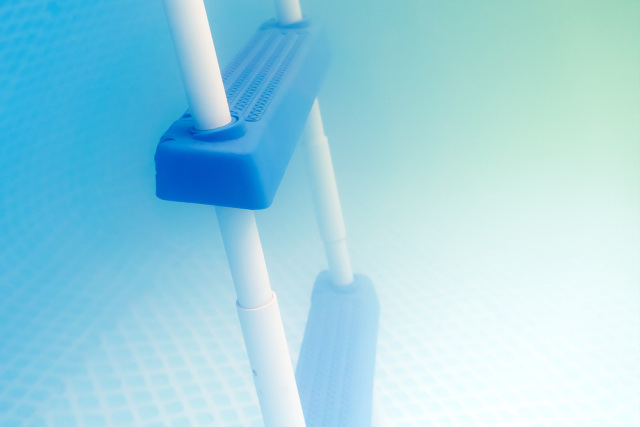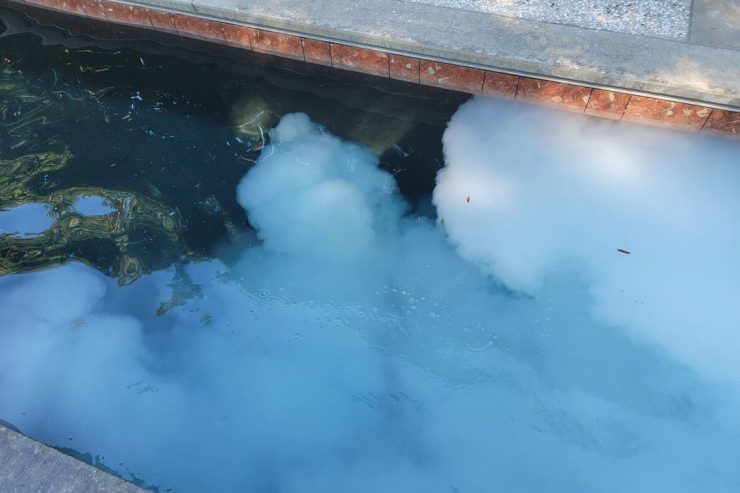Soda ash can work wonders when it comes to raising the pH of your pool, but using it incorrectly will cause the water to become extremely cloudy. Luckily, there are a few ways to clear “milky” water caused by soda ash or another pH increaser.
Though there are a few different methods, the most effective way to fix cloudy water is by maintaining neutral pH while aerating the pool. If you’re looking for faster results, you’ll have to either use a chelating product or do a partial drain.
You’re probably wondering how you’re supposed to aerate the thousands of gallons of water in your pool. And can the milky water problem be prevented? Why exactly did your pool become clouded in the first place? Look no further – our guide includes everything you need to know.

Article Contents
Why Does Soda Ash (ph Increaser) Make Pool Water Cloudy?
Like most pool owners, chances are you use soda ash as a way to increase pH. With its low price, water-softening properties, and pH of 11.4 – 11.9, sodium carbonate is one of the most widely used pool additives out there.
But what most people don’t realize is that adding a pH increaser also raises the water’s TA (total alkalinity). And that’s where the problem lies.
When the pH and TA are both raised high enough, the Calcium Hardness(CH) follows suit. As a result, the calcium dissolved in your pool begins to precipitate, forming calcium carbonate. In other words, it’s going from a liquid to a solid.
In fact, the cloudiness you see after adding too much soda ash is actually made up of calcium carbonate particles, not the soda ash itself.
On a practical level, there are three common mistakes that lead to clouding after you add a pH increaser.
1. Adding Too Much Soda Ash at Once
Adding too much soda ash at once can oversaturate the water. Never add more than 1 pound of soda ash per 10,000 gallons of water at a time. If the pH is still too low, we recommend waiting at least six hours before adding more increaser.

2. Adding Soda Ash Directly to the Pool
Soda ash should always be dissolved in a bucket of water first. This may or may not apply to other pH increaser products, so make sure to follow the instructions on the label.
3. Incorrectly Adding to Pool
The solution should never be poured into one side of the pool. That is, don’t dump it all in one spot. Instead, distribute the dissolved soda ash as evenly as possible. Do this by walking around the pool’s edge, whilst slowly pouring the soda ash and water solution into the pool.
Related Reading: Can You Over Shock Pool? Pool Now Cloudy
How Long Will The Pool Stay Cloudy?
The amount of time it takes for the pool to clear up varies according to a number of factors.
- Calcium saturation
- Aeration
- pH levels
First and foremost it depends on the level of calcium saturation. The higher the initial calcium hardness, the more calcium carbonate will be precipitated into your pool. Aeration and pH levels play a major role as well.
To give you an average, assuming your filter is running 24/7 the water should clear up over the course of 1-3 days. That being said, if your calcium hardness was higher than average, the process can take weeks.
On the other hand, if there was minimal calcium hardness and you simply added too much soda ash in one spot, the water should be clear again within a few hours.
Related Reading: Cloudy Pool Water: Why & How to Remedy
Will It Clear Up On Its Own?
With enough time, your pool will lose the cloudiness all by itself. But not only will the process take a long time, but it’ll also leave you with the same issues you had before adding the pH increaser.
Filtering slowly removes the calcium carbonate particles from the water. Plus, natural aeration raises the pH without affecting total alkalinity. That allows some of the carbonate to revert to bicarbonate, which helps dissolve the calcium back into the pool water. Of course, this also means that you’ll need to re-balance the pH again once the cloudiness is gone.

What’s the Fastest Way to Clear Cloudy Water?
As we’ve established, the root cause of the clouding is the combination of high pH, total alkalinity (TA), and calcium hardness levels. There is simply no efficient way to decrease calcium hardness directly.
As such, it’s only logical to focus on decreasing pH and total alkalinity (TA). There are plenty of ways to alter acidity and TA, but which is the fastest method?
Considering the fact that soda ash was initially added to increase the pH, the ideal fix for cloudy water will result in a pool that’s not only clear but also pH balanced. That’s why the clear winner when it comes to speed and efficiency is a combination of aeration and acids.
The goal is to maintain a pH of 6.6 – 7.1 while aerating the water as much as possible.
Simply adding a lot of pH decreaser may seem like a good idea. But while it would help with the acidity, it would also raise total alkalinity. This is where aeration comes in.
When exposed to air, your pool water releases carbon dioxide (CO2), which lowers its alkalinity. As a result, aeration also gradually raises the pH. By aerating while gradually adding pH decreaser to maintain a neutral pH of around 7, both the pH and TA levels can be quickly normalized.
The lower the pH, the faster CO2 is outgassed. Plus, maintaining the pH guarantees that once the water is clear, your pool is ready for use.
Aerating the Pool to Increase pH & Reduce Cloudy Water
You’re probably wondering how it’s possible to expose your pool to even more air. Well, the trick to it is actually not so much about adding air, as it is about creating turbulence. There are a number of simple tools you can use for pool aeration.
Submersible Water Pump
- For indoor/outdoor use
- Oil-free
- Environmentally safe
Place the pump in a shallow spot and point it upwards, at an angle. Try to position it in a way that maximizes splashing.
Turn on Water Features & Jets
If you have any similar fixtures, such as fountains or pool misters, they will certainly help as well. The same goes for the return jets, switch them on. Just make sure to angle them in a way that creates as much turbulence as possible.
Air Compressor
- Inflate and deflate items
- With 3 nozzles of different sizes
- Small and lightweight
You’ll need a compressor, a long hose, and something to weigh down the hose in the pool. This option leaves a lot of room for creativity. Some people make small holes along a hose extender for maximum impact. Others simply place it in the deep end and let it run.
Pro Tip: It may be hard to retrieve a heavy weight from the bottom of your pool. An easy solution is tying a dog leash to a weight. Then you can tie the air hose to the leash. The leash turns the weight into an anchor that can be lifted when required.
Luck!
Believe it or not, the most effective aerator is heavy rain. Predicting the weather can be tricky but if you get lucky, all you have to do is keep the pool uncovered.
Alternative Ways to Clear a Cloudy Pool After Adding Soda Ash
If you don’t have the equipment (or the patience) to maintain a balanced pH while aerating, there are a few other options. Here are the two quickest ones:
1. Partial Drain
Draining and diluting your pool with clean water is a work-intensive, yet effective way to get rid of the cloudiness. Depending on the severity of the problem, you may need to drain as much as 50% of the water.
Just remember, don’t leave the pool half empty for long, as that may damage the lining.
2. Chelant
We recommend the Orenda SC-1000, but most other chelating liquids are up to this task as well. When calcium is chelated, it is much less likely to bond with carbonate. For best results, add the chelant before using soda ash. You can get the Orenda SC-1000 here:
- Environmentally friendly product, suitable for pools & spas
- Prevents metal staining and scale formation
- Reduces calcium scale in pool heaters & chlorine generators
Tips to Avoid Cloudy Water when Adding Soda Ash
Chelating products aside, there are ways to help avoid clouding your pool with pH Increaser in the future. Follow these tips and tricks to stay ahead of the problem:
Use Borax Instead
Both soda ash and borax are sodium-based compounds, most commonly used to raise pH in swimming pools. However, unlike soda ash, borax does not affect total alkalinity. Plus, borax also helps keep the pH stable, which increases the life of your pool lining (if you have one) and lightens your pool maintenance workload. We recommend a borax like this one:
- Multipurpose cleaning agent
- DIY laundry soap, fabric softener & carpet freshener
- Always pure ingredients with no additives
Related Reading: What’s Best: Borax, Baking Soda, or Soda Ash for a Pool?
Use Aeration Instead
As we already mentioned, aeration decreases alkalinity, while increasing pH. So, as long as your alkalinity doesn’t fall below recommended levels, the best way to increase pH is simply aerating the pool. Aside from borax, this is the only way to raise pH without also raising TA.
Dilute Calcium Hardness Before Increasing pH
If your Calcium Hardness (CH) is moderate when you add the soda ash, long-lasting cloudiness simply cannot occur. So, before you add soda ash or pH increaser, measure the CH. If it’s high, dilute the water until the CH is low enough.
Take a Less-Is-More Approach
In most cases, “milky” pools are the result of improper use of soda ash. Simply making sure you add small amounts at a time can make all the difference. Soda Ash should be added in small increments and distributed evenly around the pool.
Related Reading: Soda Ash or Baking Soda for Pool | Which is Better?





